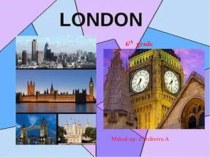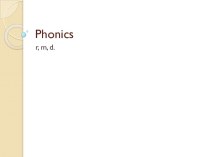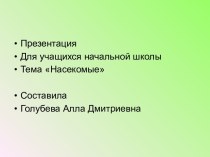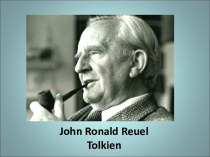- Главная
- Разное
- Бизнес и предпринимательство
- Образование
- Развлечения
- Государство
- Спорт
- Графика
- Культурология
- Еда и кулинария
- Лингвистика
- Религиоведение
- Черчение
- Физкультура
- ИЗО
- Психология
- Социология
- Английский язык
- Астрономия
- Алгебра
- Биология
- География
- Геометрия
- Детские презентации
- Информатика
- История
- Литература
- Маркетинг
- Математика
- Медицина
- Менеджмент
- Музыка
- МХК
- Немецкий язык
- ОБЖ
- Обществознание
- Окружающий мир
- Педагогика
- Русский язык
- Технология
- Физика
- Философия
- Химия
- Шаблоны, картинки для презентаций
- Экология
- Экономика
- Юриспруденция
Что такое findslide.org?
FindSlide.org - это сайт презентаций, докладов, шаблонов в формате PowerPoint.
Обратная связь
Email: Нажмите что бы посмотреть
Презентация на тему United Nations Charter
Содержание
- 2. Problem: Structure and functions of the UN
- 3. Plan:1. The Charter of The United Nations.2.
- 4. The Charter of the United Nations is the foundational treaty of the international
- 5. Structure.Chapter I sets forth the purposes of the
- 6. The main chapters of Charter.
- 7. The Preamble to the treaty reads as
- 8. Chapter I: Purposes And PrinciplesArticle 1The Purposes
- 9. Chapter II of the United Nations Charter deals with
- 10. Chapter III of the United Nations Charter lays out
- 11. Chapter V of the United Nations Charter contains provisions
- 12. Chapter X of the United Nations Charter deals with
- 13. Chapter XIX of the United Nations Charter deals with ratification and
- 14. Скачать презентацию
- 15. Похожие презентации

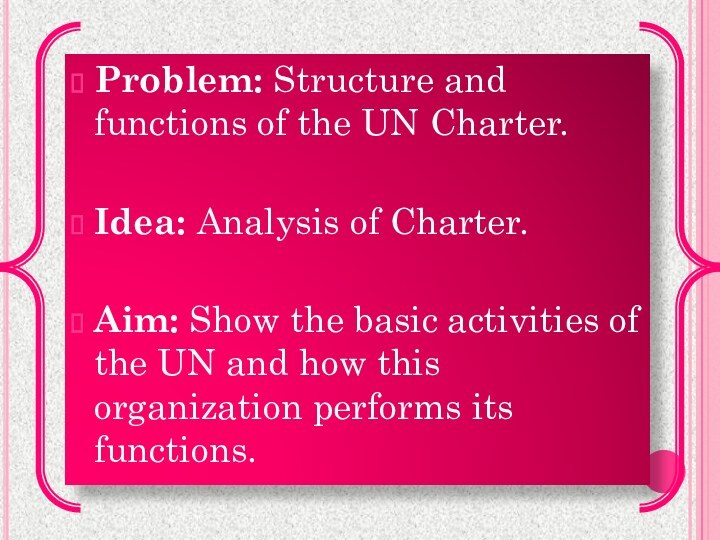


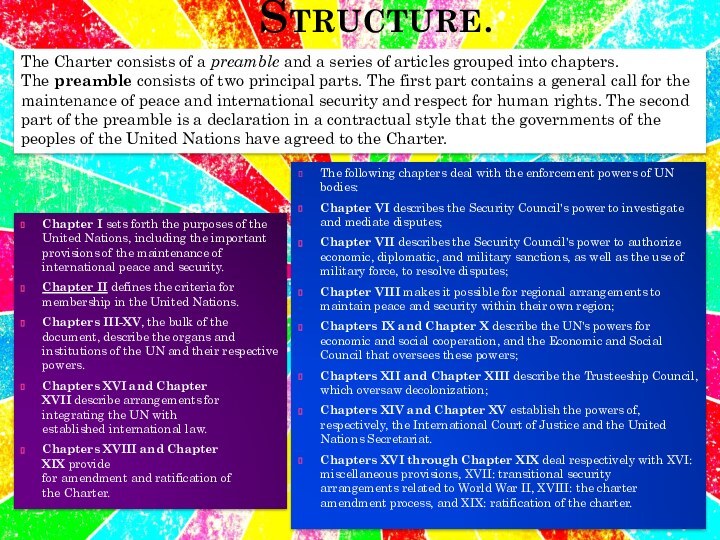
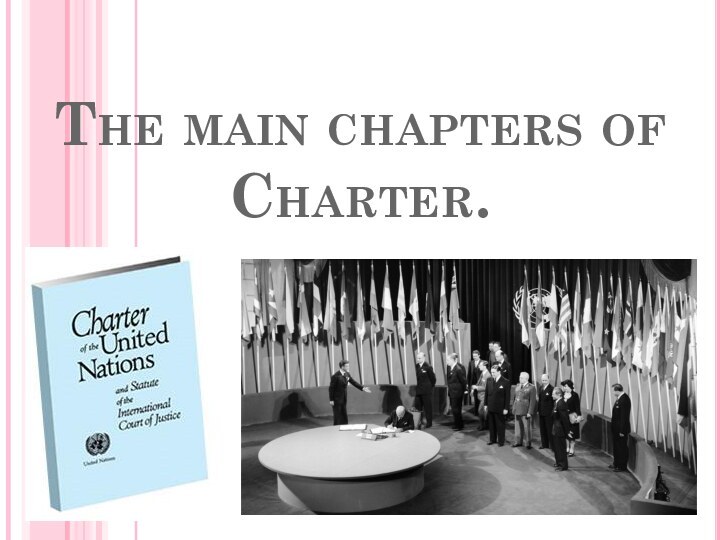
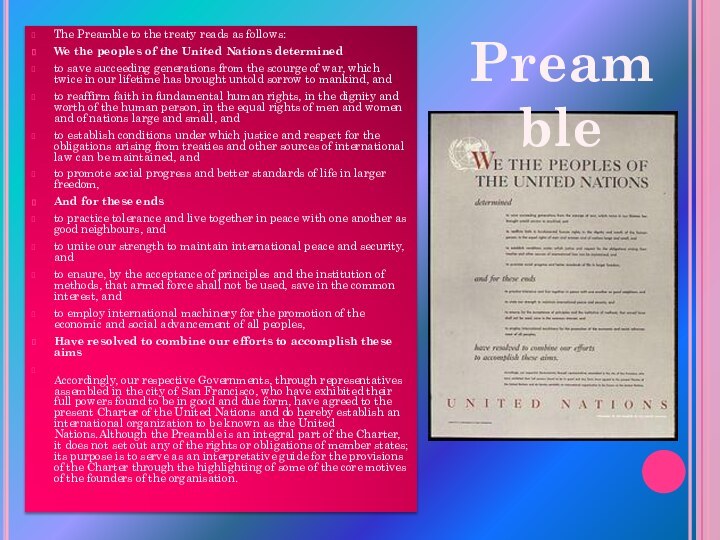



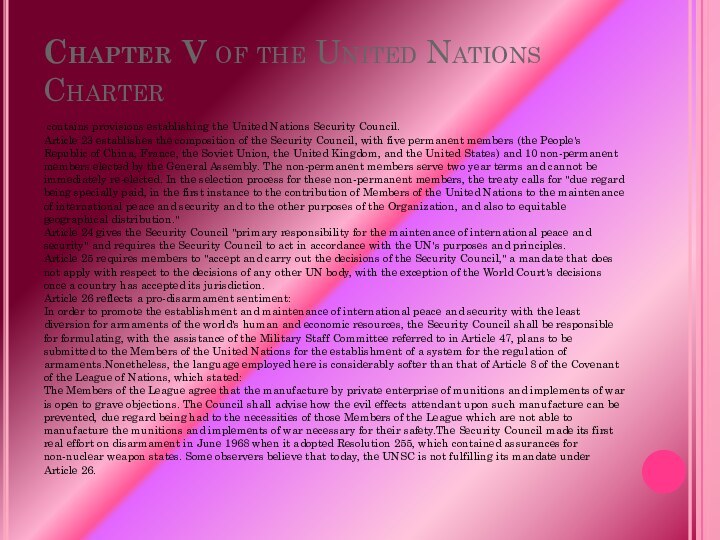

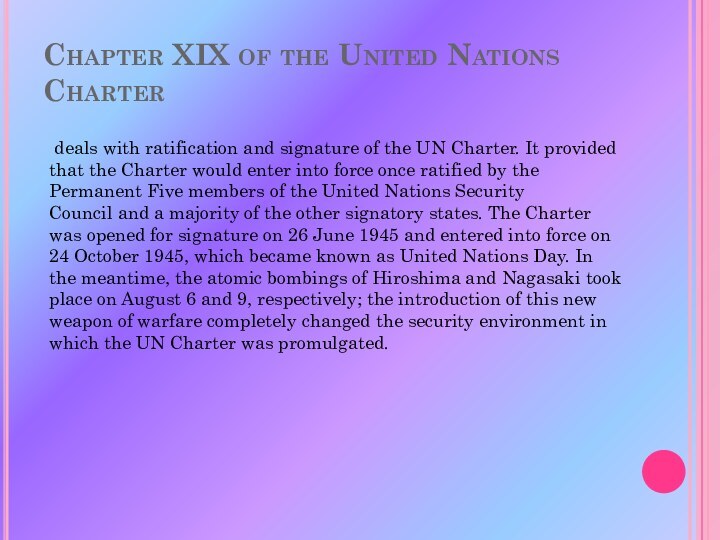

Слайд 2 Problem: Structure and functions of the UN Charter.
Слайд 3
Plan:
1. The Charter of The United Nations.
2. Structure.
3.
The main chapters of Charter.
a. Preamble.
b. Chapter I.
c. Chapter
II.d. Chapter III.
e. Chapter V.
f. Chapter X.
g. Chapter XIX.
List of used literature:
http://en.wikipedia.org/wiki/United_Nations_Charter
https://www.un.org/en/documents/charter/
https://treaties.un.org/doc/publication/ctc/uncharter.pdf
http://www.icj-cij.org/documents/index.php?p1=4&p2=1&
Слайд 4
The Charter of the United Nations
is the foundational treaty of the international organization called
the United Nations. It was signed at the San Francisco War
Memorial and Performing Arts Center in San Francisco, United States, on 26 June 1945, by 50 of the 51 original member countries. (Poland, the other original member, which was not represented at the conference, signed it two months later.) It entered into force on 24 October 1945, after being ratified by the five permanent members of the Security Council—the Republic of China under Chapter II of the United Nations Charter (and currently by the People's Republic of China), France, the Union of Soviet Socialist Republics (later replaced by the Russian Federation), the United Kingdom, and the United States—and a majority of the other signatories.As a charter, it is a constituent treaty, and all members are bound by its articles. Furthermore, Article 103 of the Charter states that obligations to the United Nations prevail over all other treaty obligations. Most countries in the world have now ratified the Charter.
Слайд 5
Structure.
Chapter I sets forth the purposes of the United
Nations, including the important provisions of the maintenance of
international peace and security.Chapter II defines the criteria for membership in the United Nations.
Chapters III-XV, the bulk of the document, describe the organs and institutions of the UN and their respective powers.
Chapters XVI and Chapter XVII describe arrangements for integrating the UN with established international law.
Chapters XVIII and Chapter XIX provide for amendment and ratification of the Charter.
The following chapters deal with the enforcement powers of UN bodies:
Chapter VI describes the Security Council's power to investigate and mediate disputes;
Chapter VII describes the Security Council's power to authorize economic, diplomatic, and military sanctions, as well as the use of military force, to resolve disputes;
Chapter VIII makes it possible for regional arrangements to maintain peace and security within their own region;
Chapters IX and Chapter X describe the UN's powers for economic and social cooperation, and the Economic and Social Council that oversees these powers;
Chapters XII and Chapter XIII describe the Trusteeship Council, which oversaw decolonization;
Chapters XIV and Chapter XV establish the powers of, respectively, the International Court of Justice and the United Nations Secretariat.
Chapters XVI through Chapter XIX deal respectively with XVI: miscellaneous provisions, XVII: transitional security arrangements related to World War II, XVIII: the charter amendment process, and XIX: ratification of the charter.
The Charter consists of a preamble and a series of articles grouped into chapters.
The preamble consists of two principal parts. The first part contains a general call for the maintenance of peace and international security and respect for human rights. The second part of the preamble is a declaration in a contractual style that the governments of the peoples of the United Nations have agreed to the Charter.
Слайд 7
The Preamble to the treaty reads as follows:
We
the peoples of the United Nations determined
to save succeeding
generations from the scourge of war, which twice in our lifetime has brought untold sorrow to mankind, andto reaffirm faith in fundamental human rights, in the dignity and worth of the human person, in the equal rights of men and women and of nations large and small, and
to establish conditions under which justice and respect for the obligations arising from treaties and other sources of international law can be maintained, and
to promote social progress and better standards of life in larger freedom,
And for these ends
to practice tolerance and live together in peace with one another as good neighbours, and
to unite our strength to maintain international peace and security, and
to ensure, by the acceptance of principles and the institution of methods, that armed force shall not be used, save in the common interest, and
to employ international machinery for the promotion of the economic and social advancement of all peoples,
Have resolved to combine our efforts to accomplish these aims
Accordingly, our respective Governments, through representatives assembled in the city of San Francisco, who have exhibited their full powers found to be in good and due form, have agreed to the present Charter of the United Nations and do hereby establish an international organization to be known as the United Nations.Although the Preamble is an integral part of the Charter, it does not set out any of the rights or obligations of member states; its purpose is to serve as an interpretative guide for the provisions of the Charter through the highlighting of some of the core motives of the founders of the organisation.
Preamble
Слайд 8
Chapter I: Purposes And Principles
Article 1
The Purposes of
the United Nations are
To maintain international and security, to take
effective collective measures for the prevention and removal of threats to the peace, and for the suppression of acts of aggression or other breaches of the peace, and to bring about by peaceful means, and in conformity with the principles of justice and international law, adjustment or settlement of international disputes or situations which might lead to a breach of the peace;To develop friendly relations among nations based on respect for the principle of equal rights and self-determination of peoples, and to take other appropriate measures to strengthen universal peace;
To achieve international co-operation in solving international problems of an economic, social, cultural, or humanitarian character, and in promoting and encouraging respect for human rights and for fundamental freedoms for all without distinction as to race, sex, language, or religion; and
To be a centre for harmonizing the actions of nations in the attainment of these common ends.
Article 2
The Organization and its Members, in pursuit of the Purposes stated in Article 1, shall act in accordance with the following Principles:
The Organization is based on the principle of the sovereign equality of all its Members.
All Members, in order to ensure to all of them the rights and benefits resulting from membership, shall fulfill in good faith the obligations assumed by them in accordance with the present Charter.
All Members shall settle their international disputes by peaceful means in such a manner that international peace and security, and justice, are not endangered.
All Members shall refrain in their international relations from the threat or use of force against the territorial integrity or political independence of any state, or in any other manner inconsistent with the Purposes of the United Nations.
All Members shall give the United Nations every assistance in any action it takes in accordance with the present Charter, and shall refrain from giving assistance to any state against which the United Nations is taking preventive or enforcement action.
The Organization shall ensure that states which are not Members of the United Nations act in accordance with these Principles so far as may be necessary for the maintenance of international peace and security.
Nothing contained in the present Charter shall authorize the United Nations to intervene in matters which are essentially within the domestic jurisdiction of any state or shall require the Members to submit such matters to settlement under the present Charter; but this principle shall not prejudice the application of enforcement measures under Chapter Vll.
Слайд 9
Chapter II
of the United Nations Charter deals with membership
of the United Nations organization. Membership is open to the original
signatories and "all other peace-loving states which accept the obligations contained in the present Charter and, in the judgment of the Organization, are able and willing to carry out these obligations." A country can only be admitted to the UN after the UN General Assembly votes to do so upon the recommendation of the UN Security Council. The required assent of the permanent five (P5) members of the Security Council (People's Republic of China, France, Russian Federation, the United Kingdom, and the United States of America) no doubt accounts for why admission to membership in the UN is regarded as an important indicator of sovereignty and legitimate statehood (especially for microstates). On the other hand, some de facto-acknowledged independently-governed countries such as Taiwan have not been admitted to the UN due a veto by a P5 member. During the Cold War, the USA and the USSR did not allow the admission of countries from rival blocs for a while, but then began letting those countries join, which led to a period of great expansion of UN membership, especially as the number of sovereign countries increased due to colonies gaining independence.Chapter II also provides for the suspension and expulsion of member countries from the UN by the UN General Assembly upon the recommendation of the UN Security Council, and for the restoration of rights to suspended members by the Security Council. Partly because of the procedure set out in this chapter, Taiwan has questioned the legality of United Nations General Assembly Resolution 2758 which declared that the People's Republic of China was the legitimate holder of the Chinese seat and that the Taiwanese delegation of Republic of China was questionably to be expelled forthwith and the entry of the People's Republic of China's Membership nor initially granting the recommendation by Republic of China in the Security Council before the General Assembly. In 2005, Israel called for the expulsion of Iran, apparently interpreting the latter's calls for the destruction of Israel as having "persistently violated the Principles contained in the present Charter" and thus meeting the Article 6 criteria for expulsion.
Слайд 10
Chapter III
of the United Nations Charter lays out the
principal organs of the United Nations, and announces a gender
nondiscrimination policy for United Nations hiring.They are listed in the same order as the chapters detailing their composition, functions, and powers appear in the Charter. The placement of the General Assembly first in the list probably is due to the founders' intention that the UNGA be the "first branch" or core of the UN system. Chapter III establishes:
The UN General Assembly;
The UN Security Council;
The UN Economic and Social Council;
The UN Trusteeship Council;
The International Court of Justice; and
The UN Secretariat.
Additionally, Chapter III authorizes the establishment of subsidiary bodies to these organs, which are typically also authorized in the chapters relating to those principal organs. Chapter III also has an equal opportunity provision banning "restrictions on the eligibility of men and women to participate in any capacity and under conditions of equality in its principal and subsidiary organs." Chapter III sets up a more complex organizational structure than Article 2 of the Covenant of the League of Nations, which simply provided, "The action of the League under this Covenant shall be effected through the instrumentality of an Assembly and of a Council, with a permanent Secretariat," establishing a three-organ system as opposed to a six-organ system.
Слайд 11
Chapter V of the United Nations Charter
contains provisions establishing
the United Nations Security Council.
Article 23 establishes the composition of
the Security Council, with five permanent members (the People's Republic of China, France, the Soviet Union, the United Kingdom, and the United States) and 10 non-permanent members elected by the General Assembly. The non-permanent members serve two year terms and cannot be immediately re-elected. In the selection process for these non-permanent members, the treaty calls for "due regard being specially paid, in the first instance to the contribution of Members of the United Nations to the maintenance of international peace and security and to the other purposes of the Organization, and also to equitable geographical distribution."Article 24 gives the Security Council "primary responsibility for the maintenance of international peace and security" and requires the Security Council to act in accordance with the UN's purposes and principles.
Article 25 requires members to "accept and carry out the decisions of the Security Council," a mandate that does not apply with respect to the decisions of any other UN body, with the exception of the World Court's decisions once a country has accepted its jurisdiction.
Article 26 reflects a pro-disarmament sentiment:
In order to promote the establishment and maintenance of international peace and security with the least diversion for armaments of the world's human and economic resources, the Security Council shall be responsible for formulating, with the assistance of the Military Staff Committee referred to in Article 47, plans to be submitted to the Members of the United Nations for the establishment of a system for the regulation of armaments.Nonetheless, the language employed here is considerably softer than that of Article 8 of the Covenant of the League of Nations, which stated:
The Members of the League agree that the manufacture by private enterprise of munitions and implements of war is open to grave objections. The Council shall advise how the evil effects attendant upon such manufacture can be prevented, due regard being had to the necessities of those Members of the League which are not able to manufacture the munitions and implements of war necessary for their safety.The Security Council made its first real effort on disarmament in June 1968 when it adopted Resolution 255, which contained assurances for non-nuclear weapon states. Some observers believe that today, the UNSC is not fulfilling its mandate under Article 26.
